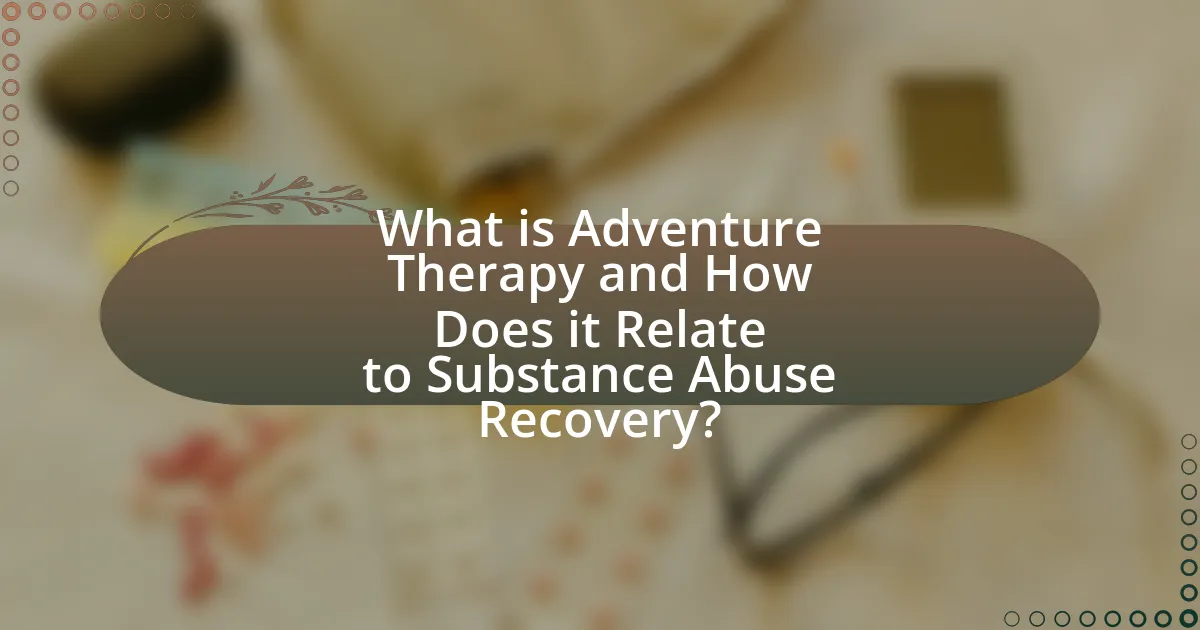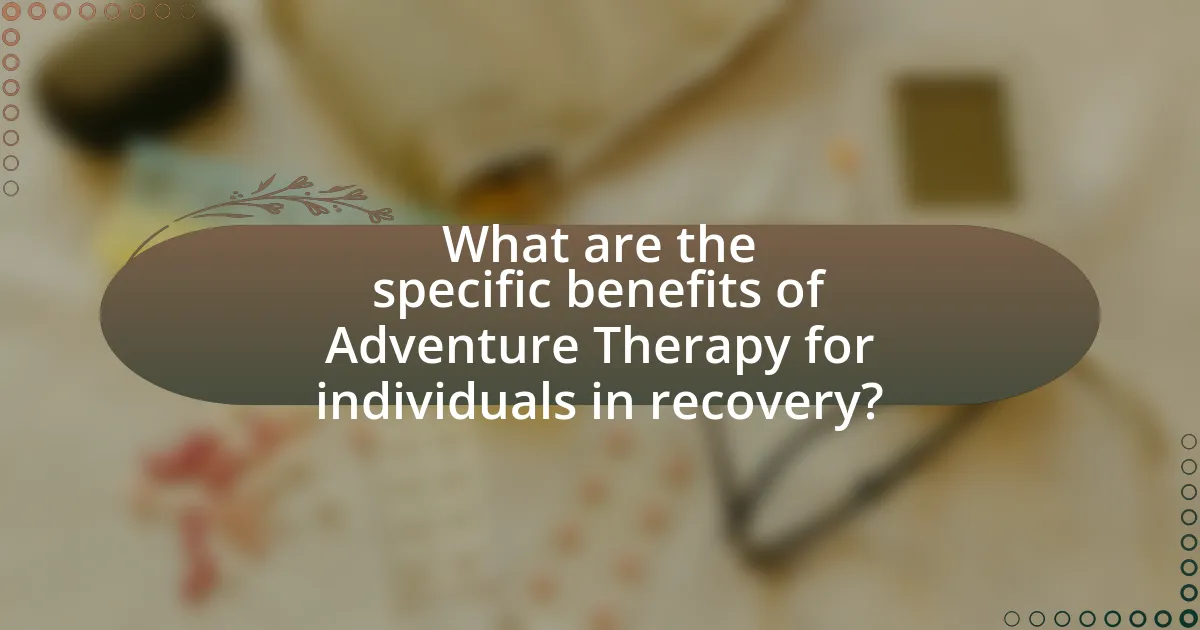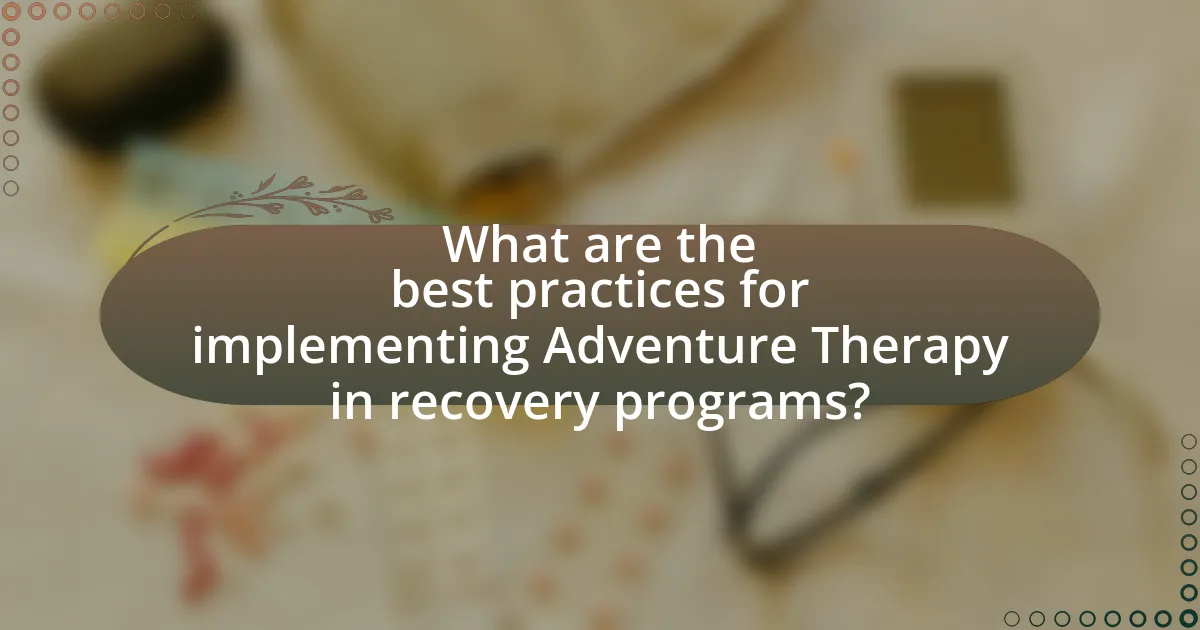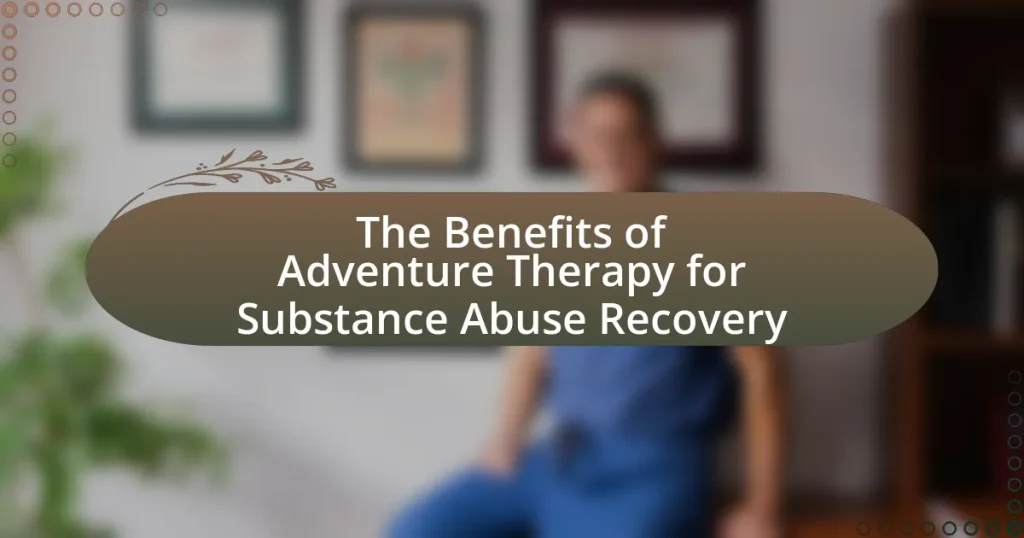Adventure therapy is a therapeutic approach that utilizes outdoor activities and experiential learning to facilitate personal growth and healing, particularly in the context of substance abuse recovery. This article explores the principles of adventure therapy, its effectiveness compared to traditional therapy methods, and the specific activities involved. It highlights the psychological and physical benefits of engaging in adventure therapy, such as enhanced self-esteem, improved coping skills, and increased social connections. Additionally, the article discusses how adventure therapy can be tailored to meet the needs of various populations and age groups, while addressing the challenges and best practices for implementation in recovery programs.

What is Adventure Therapy and How Does it Relate to Substance Abuse Recovery?
Adventure therapy is a therapeutic approach that incorporates outdoor activities and experiential learning to promote personal growth and healing. It relates to substance abuse recovery by providing individuals with opportunities to build self-esteem, develop coping skills, and foster social connections in a supportive environment. Research indicates that adventure therapy can enhance treatment outcomes for substance use disorders by engaging participants in physical challenges that encourage teamwork, resilience, and self-discovery, ultimately aiding in the recovery process.
What are the key principles of Adventure Therapy?
The key principles of Adventure Therapy include experiential learning, therapeutic alliance, and the use of nature as a healing environment. Experiential learning emphasizes hands-on activities that promote personal growth and self-discovery, allowing individuals to confront challenges in a supportive setting. The therapeutic alliance focuses on building trust and rapport between the therapist and the participant, which is crucial for effective treatment. Additionally, utilizing nature as a healing environment enhances emotional well-being and fosters resilience, as studies have shown that outdoor activities can reduce stress and improve mental health outcomes.
How does Adventure Therapy differ from traditional therapy methods?
Adventure Therapy differs from traditional therapy methods by incorporating experiential activities in natural settings to facilitate healing and personal growth. Traditional therapy typically relies on talk-based approaches within a clinical environment, focusing on verbal communication and cognitive processes. In contrast, Adventure Therapy engages clients in physical challenges, such as hiking or rock climbing, which can enhance self-efficacy and promote emotional expression. Research indicates that these activities can lead to improved outcomes in substance abuse recovery by fostering resilience and teamwork, as evidenced by studies showing increased motivation and reduced relapse rates among participants in Adventure Therapy programs compared to those in conventional therapy settings.
What activities are typically involved in Adventure Therapy?
Adventure Therapy typically involves activities such as rock climbing, hiking, canoeing, and team-building exercises. These activities are designed to promote personal growth, enhance coping skills, and foster social connections among participants. Research indicates that engaging in outdoor activities can lead to improved mental health outcomes, as evidenced by a study published in the Journal of Adventure Education and Outdoor Learning, which found that participants in adventure therapy reported increased self-esteem and reduced anxiety levels.
Why is Adventure Therapy effective for substance abuse recovery?
Adventure Therapy is effective for substance abuse recovery because it engages individuals in experiential learning through outdoor activities, which fosters personal growth and emotional healing. This therapeutic approach promotes self-efficacy, enhances coping skills, and encourages social interaction, all of which are crucial for overcoming addiction. Research indicates that participants in Adventure Therapy programs report increased motivation and reduced substance use, as evidenced by a study published in the Journal of Substance Abuse Treatment, which found that 70% of participants showed significant improvement in their recovery outcomes after engaging in such programs.
What psychological benefits does Adventure Therapy provide?
Adventure Therapy provides psychological benefits such as enhanced self-esteem, improved emotional regulation, and increased resilience. These benefits arise from engaging in challenging outdoor activities that promote personal growth and self-discovery. Research indicates that participants often experience reduced anxiety and depression, as the immersive nature of adventure therapy fosters a sense of accomplishment and connection with others. A study published in the Journal of Adventure Education and Outdoor Learning found that individuals who participated in adventure therapy reported significant improvements in mental health outcomes, highlighting its effectiveness in promoting psychological well-being.
How does Adventure Therapy promote physical well-being?
Adventure Therapy promotes physical well-being by engaging individuals in outdoor activities that enhance fitness and overall health. These activities, such as hiking, climbing, and kayaking, require physical exertion, which improves cardiovascular health, builds strength, and increases endurance. Research indicates that physical activity can lead to a reduction in substance cravings and withdrawal symptoms, thereby supporting recovery from substance abuse. Additionally, the natural environment associated with Adventure Therapy has been shown to reduce stress and anxiety, further contributing to improved physical health outcomes.
What populations can benefit from Adventure Therapy in recovery?
Adventure Therapy can benefit various populations in recovery, including individuals with substance use disorders, adolescents facing behavioral issues, veterans dealing with PTSD, and those with mental health challenges such as anxiety and depression. Research indicates that these groups often experience improved coping skills, enhanced self-esteem, and increased social connections through experiential learning in nature. For instance, a study published in the Journal of Substance Abuse Treatment found that participants in Adventure Therapy reported significant reductions in substance use and improved psychological well-being. This evidence supports the effectiveness of Adventure Therapy in facilitating recovery across diverse populations.
How does Adventure Therapy cater to different age groups?
Adventure Therapy caters to different age groups by tailoring activities and therapeutic approaches to meet the developmental and emotional needs of each group. For children and adolescents, Adventure Therapy often incorporates play-based activities that promote teamwork, communication, and self-esteem, which are crucial for their growth and recovery. In contrast, adults may engage in more challenging outdoor experiences that focus on personal responsibility, resilience, and coping strategies, which are essential for overcoming substance abuse. Research indicates that age-appropriate interventions enhance engagement and effectiveness, as demonstrated in studies showing improved outcomes in youth and adult populations participating in tailored Adventure Therapy programs.
What specific challenges do individuals with substance abuse issues face that Adventure Therapy addresses?
Individuals with substance abuse issues face challenges such as low self-esteem, social isolation, and difficulty managing stress and emotions. Adventure Therapy addresses these challenges by promoting self-efficacy through experiential learning, fostering social connections in group settings, and providing coping strategies through outdoor activities. Research indicates that engaging in adventure-based activities can enhance emotional regulation and resilience, which are critical for recovery. For instance, a study published in the Journal of Substance Abuse Treatment found that participants in Adventure Therapy reported significant improvements in self-esteem and social skills compared to traditional therapy methods.
How can Adventure Therapy be integrated into a comprehensive recovery program?
Adventure Therapy can be integrated into a comprehensive recovery program by incorporating experiential activities that promote personal growth, resilience, and social skills. This integration can involve structured outdoor activities such as hiking, rock climbing, or team-building exercises, which facilitate emotional expression and foster a sense of community among participants. Research indicates that such activities can enhance coping strategies and reduce relapse rates; for instance, a study published in the Journal of Substance Abuse Treatment found that participants in adventure therapy reported significant improvements in self-efficacy and social support compared to traditional therapy methods. By combining these experiential elements with traditional therapeutic approaches, recovery programs can create a holistic environment that addresses both the psychological and physical aspects of substance abuse recovery.
What are the potential challenges of implementing Adventure Therapy?
The potential challenges of implementing Adventure Therapy include logistical issues, safety concerns, and the need for trained professionals. Logistical issues arise from the requirement for suitable outdoor locations, transportation, and equipment, which can complicate program planning and execution. Safety concerns are paramount, as adventure activities carry inherent risks that necessitate thorough risk assessments and safety protocols to protect participants. Additionally, the effectiveness of Adventure Therapy relies heavily on the presence of trained professionals who can facilitate activities and provide therapeutic support, which may be a barrier due to the limited availability of qualified practitioners in this specialized field.

What are the specific benefits of Adventure Therapy for individuals in recovery?
Adventure Therapy provides several specific benefits for individuals in recovery, including enhanced self-esteem, improved coping skills, and increased social support. Engaging in outdoor activities fosters a sense of accomplishment, which can significantly boost self-esteem. Research indicates that physical challenges in nature can lead to better emotional regulation and resilience, essential for managing cravings and stress. Additionally, Adventure Therapy often involves group activities, promoting social interaction and support, which are crucial for recovery. Studies show that social support networks can reduce relapse rates, making these connections vital for long-term sobriety.
How does Adventure Therapy enhance self-esteem and confidence?
Adventure Therapy enhances self-esteem and confidence by providing individuals with challenging experiences that promote personal growth and achievement. Engaging in activities such as rock climbing, hiking, or team-building exercises allows participants to confront fears, develop problem-solving skills, and experience a sense of accomplishment. Research indicates that these activities can lead to improved self-perception and resilience, as individuals learn to trust their abilities and make decisions in high-pressure situations. A study published in the Journal of Adventure Education and Outdoor Learning found that participants in adventure therapy reported significant increases in self-esteem and confidence levels after completing structured outdoor activities.
What role does teamwork play in building self-esteem during Adventure Therapy?
Teamwork plays a crucial role in building self-esteem during Adventure Therapy by fostering a sense of belonging and mutual support among participants. Engaging in collaborative tasks allows individuals to contribute their strengths, which enhances their confidence and reinforces their self-worth. Research indicates that group activities in therapeutic settings lead to improved social skills and emotional resilience, as participants learn to rely on one another and celebrate collective achievements. This dynamic not only cultivates trust but also empowers individuals to face challenges, thereby significantly boosting their self-esteem throughout the recovery process.
How do personal achievements in Adventure Therapy contribute to confidence building?
Personal achievements in Adventure Therapy significantly contribute to confidence building by providing individuals with tangible evidence of their capabilities. When participants successfully complete challenging activities, such as rock climbing or navigating a ropes course, they experience a sense of accomplishment that reinforces their self-efficacy. Research indicates that these experiences can lead to improved self-esteem and resilience, as individuals learn to trust their skills and judgment in high-pressure situations. For instance, a study published in the Journal of Adventure Education and Outdoor Learning found that participants reported increased confidence and personal growth after engaging in Adventure Therapy programs, highlighting the direct correlation between achievement and self-assurance.
In what ways does Adventure Therapy foster social connections?
Adventure Therapy fosters social connections by promoting teamwork and communication among participants. Engaging in shared outdoor activities, such as hiking or rock climbing, requires individuals to collaborate, which enhances their ability to connect with others. Research indicates that these group experiences can lead to improved interpersonal skills and a sense of belonging, as participants often share challenges and successes, fostering trust and camaraderie. A study published in the Journal of Substance Abuse Treatment found that participants in Adventure Therapy reported increased social support and stronger relationships with peers, highlighting the effectiveness of this therapeutic approach in building social networks essential for recovery.
How does group participation in Adventure Therapy improve social skills?
Group participation in Adventure Therapy enhances social skills by fostering teamwork, communication, and trust among participants. Engaging in shared challenges and activities requires individuals to collaborate, which promotes effective verbal and non-verbal communication. Research indicates that such collaborative environments can lead to improved interpersonal relationships and social interactions. For instance, a study published in the Journal of Adventure Education and Outdoor Learning found that participants in group adventure activities reported increased confidence in social situations and better conflict resolution skills. This evidence supports the notion that Adventure Therapy not only aids in personal recovery but also cultivates essential social competencies.
What impact do peer relationships formed during Adventure Therapy have on recovery?
Peer relationships formed during Adventure Therapy significantly enhance recovery from substance abuse. These relationships provide emotional support, foster a sense of belonging, and encourage accountability among participants. Research indicates that social connections are crucial for recovery, as they can reduce feelings of isolation and promote positive behavioral changes. A study published in the Journal of Substance Abuse Treatment found that individuals who engaged in group-based therapies, including Adventure Therapy, reported higher levels of motivation and commitment to sobriety due to the support from peers. This collaborative environment not only aids in coping with challenges but also reinforces the skills learned during therapy, ultimately leading to improved recovery outcomes.
How does Adventure Therapy aid in coping with triggers and cravings?
Adventure Therapy aids in coping with triggers and cravings by providing immersive, experiential activities that promote emotional regulation and resilience. Engaging in outdoor challenges, such as rock climbing or hiking, helps individuals confront and manage stressors in a controlled environment, thereby reducing the likelihood of relapse. Research indicates that these activities can enhance self-efficacy and foster a sense of community, which are crucial for maintaining sobriety. For instance, a study published in the Journal of Substance Abuse Treatment found that participants in Adventure Therapy reported lower levels of cravings and improved coping strategies compared to traditional therapy methods.
What techniques are taught in Adventure Therapy to manage cravings?
Adventure Therapy teaches techniques such as mindfulness, physical activity, and experiential learning to manage cravings. Mindfulness practices help individuals become aware of their cravings without judgment, allowing them to respond rather than react. Physical activities, such as hiking or climbing, provide a healthy outlet for stress and can distract from cravings. Experiential learning through challenges in nature fosters resilience and coping skills, which are essential for managing cravings effectively. These techniques are supported by research indicating that engaging in physical activity and mindfulness can significantly reduce substance cravings and improve overall well-being.
How does exposure to nature during Adventure Therapy help in stress reduction?
Exposure to nature during Adventure Therapy significantly aids in stress reduction by promoting relaxation and enhancing mood. Natural environments have been shown to lower cortisol levels, which is a key stress hormone, and increase feelings of well-being. Research indicates that spending time in nature can lead to a decrease in anxiety and depression symptoms, as evidenced by a study published in the journal Environmental Science & Technology, which found that participants who engaged in outdoor activities reported lower stress levels compared to those who remained indoors. This connection between nature exposure and stress relief is crucial in the context of Adventure Therapy, as it not only facilitates physical activity but also fosters a sense of connection to the environment, further contributing to emotional healing and recovery from substance abuse.

What are the best practices for implementing Adventure Therapy in recovery programs?
The best practices for implementing Adventure Therapy in recovery programs include establishing clear therapeutic goals, ensuring trained facilitators lead the activities, and integrating adventure experiences with traditional therapeutic methods. Clear therapeutic goals provide direction and measurable outcomes, while trained facilitators ensure safety and effective guidance during activities. Research indicates that combining adventure therapy with traditional therapies, such as cognitive-behavioral therapy, enhances overall treatment effectiveness, as evidenced by a study published in the Journal of Substance Abuse Treatment, which found that participants reported improved coping skills and reduced substance use after engaging in adventure-based activities.
How can facilitators ensure safety during Adventure Therapy sessions?
Facilitators can ensure safety during Adventure Therapy sessions by conducting thorough risk assessments and implementing safety protocols. This involves evaluating the environment, identifying potential hazards, and preparing participants for activities through clear instructions and safety briefings. Research indicates that structured safety measures, such as using appropriate gear and having trained staff present, significantly reduce the likelihood of accidents during outdoor activities. For example, a study published in the Journal of Adventure Education and Outdoor Learning highlights that programs with established safety guidelines report fewer incidents, reinforcing the importance of proactive safety management in Adventure Therapy.
What training is required for Adventure Therapy facilitators?
Adventure Therapy facilitators typically require training in outdoor education, psychology, and counseling techniques. This training often includes certifications in wilderness first aid, risk management, and group facilitation skills. Additionally, many facilitators hold degrees in fields such as psychology, social work, or recreation therapy, which provide a foundational understanding of mental health and therapeutic practices. Research indicates that effective Adventure Therapy programs integrate these elements to ensure safety and therapeutic efficacy, thereby enhancing the recovery process for individuals dealing with substance abuse.
How can risk management be effectively handled in Adventure Therapy?
Risk management in Adventure Therapy can be effectively handled through comprehensive planning, continuous assessment, and adherence to safety protocols. Comprehensive planning involves identifying potential risks associated with specific activities, such as climbing or hiking, and developing strategies to mitigate these risks. Continuous assessment requires ongoing evaluation of participants’ physical and emotional states, ensuring that they are fit for the activities planned. Adherence to safety protocols includes using appropriate safety gear, conducting pre-activity briefings, and having trained staff available to respond to emergencies. These practices are supported by research indicating that structured risk management enhances participant safety and therapeutic outcomes in adventure-based programs.
What are the key considerations for tailoring Adventure Therapy to individual needs?
Key considerations for tailoring Adventure Therapy to individual needs include assessing the participant’s physical abilities, psychological readiness, and personal goals. Understanding these factors allows therapists to design activities that are both safe and effective, fostering engagement and promoting healing. For instance, a study published in the Journal of Adventure Education and Outdoor Learning highlights that individualized approaches significantly enhance therapeutic outcomes by aligning activities with the participant’s interests and capabilities. This tailored approach not only increases motivation but also ensures that the therapeutic experience is relevant and impactful for each individual.
How can assessments be used to customize Adventure Therapy experiences?
Assessments can be used to customize Adventure Therapy experiences by identifying individual needs, preferences, and challenges of participants. These assessments typically include psychological evaluations, physical fitness tests, and personal interviews, which help therapists tailor activities that align with each participant’s goals and capabilities. For instance, a study published in the Journal of Substance Abuse Treatment found that personalized interventions based on initial assessments significantly improved engagement and outcomes in therapy programs. By utilizing assessments, therapists can create a more effective and supportive environment that enhances the therapeutic benefits of Adventure Therapy for individuals in substance abuse recovery.
What factors should be considered when selecting activities for participants?
When selecting activities for participants in adventure therapy for substance abuse recovery, factors such as participant demographics, individual interests, physical abilities, and therapeutic goals must be considered. Understanding participant demographics, including age, gender, and cultural background, helps tailor activities that resonate with their experiences. Individual interests ensure engagement and motivation, while physical abilities dictate the safety and feasibility of activities. Therapeutic goals, such as building self-esteem or enhancing coping skills, guide the selection of activities that align with recovery objectives. Research indicates that personalized approaches in therapy enhance outcomes, as seen in studies demonstrating improved recovery rates when activities are matched to participant profiles.
What practical tips can enhance the effectiveness of Adventure Therapy for recovery?
Practical tips to enhance the effectiveness of Adventure Therapy for recovery include setting clear goals, ensuring participant safety, and incorporating reflective practices. Setting clear goals allows participants to understand their objectives, which can increase motivation and focus during activities. Ensuring participant safety is crucial, as a secure environment fosters trust and encourages individuals to engage fully in the therapeutic process. Incorporating reflective practices, such as group discussions or journaling after activities, helps participants process their experiences and integrate lessons learned into their recovery journey. Research indicates that structured reflection can significantly improve therapeutic outcomes, as it promotes self-awareness and personal growth.
